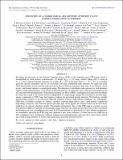| dc.contributor.author | Cenko, S. Bradley | |
| dc.contributor.author | Kulkarni, S. R. | |
| dc.contributor.author | Horesh, Assaf | |
| dc.contributor.author | Corsi, A. | |
| dc.contributor.author | Fox, Derek B. | |
| dc.contributor.author | Carpenter, John | |
| dc.contributor.author | Frail, Dale A. | |
| dc.contributor.author | Nugent, Peter E. | |
| dc.contributor.author | Perley, Daniel A. | |
| dc.contributor.author | Gruber, D. | |
| dc.contributor.author | Gal-Yam, Avishay | |
| dc.contributor.author | Groot, P. | |
| dc.contributor.author | Hallinan, G. | |
| dc.contributor.author | Ofek, Eran O. | |
| dc.contributor.author | Rau, Arne | |
| dc.contributor.author | MacLeod, Chelsea L. | |
| dc.contributor.author | Miller, Adam A. | |
| dc.contributor.author | Bloom, Joshua S. | |
| dc.contributor.author | Filippenko, Alexei V. | |
| dc.contributor.author | Kasliwal, Mansi M. | |
| dc.contributor.author | Law, Nicholas M. | |
| dc.contributor.author | Morgan, Adam N. | |
| dc.contributor.author | Polishook, David | |
| dc.contributor.author | Poznanski, Dovi | |
| dc.contributor.author | Quimby, Robert M. | |
| dc.contributor.author | Sesar, Branimir | |
| dc.contributor.author | Shen, Ken J. | |
| dc.contributor.author | Silverman, Jeffrey M. | |
| dc.contributor.author | Sternberg, Assaf | |
| dc.date.accessioned | 2015-02-04T20:11:50Z | |
| dc.date.available | 2015-02-04T20:11:50Z | |
| dc.date.issued | 2013-06 | |
| dc.date.submitted | 2013-01 | |
| dc.identifier.issn | 0004-637X | |
| dc.identifier.issn | 1538-4357 | |
| dc.identifier.uri | http://hdl.handle.net/1721.1/93758 | |
| dc.description.abstract | We report the discovery by the Palomar Transient Factory (PTF) of the transient source PTF11agg, which is distinguished by three primary characteristics: (1) bright (R[subscript peak] = 18.3 mag), rapidly fading (ΔR = 4 mag in Δt = 2 days) optical transient emission; (2) a faint (R = 26.2 ± 0.2 mag), blue (g' – R = 0.17 ± 0.29 mag) quiescent optical counterpart; and (3) an associated year-long, scintillating radio transient. We argue that these observed properties are inconsistent with any known class of Galactic transients (flare stars, X-ray binaries, dwarf novae), and instead suggest a cosmological origin. The detection of incoherent radio emission at such distances implies a large emitting region, from which we infer the presence of relativistic ejecta. The observed properties are all consistent with the population of long-duration gamma-ray bursts (GRBs), marking the first time such an outburst has been discovered in the distant universe independent of a high-energy trigger. We searched for possible high-energy counterparts to PTF11agg, but found no evidence for associated prompt emission. We therefore consider three possible scenarios to account for a GRB-like afterglow without a high-energy counterpart: an "untriggered" GRB (lack of satellite coverage), an "orphan" afterglow (viewing-angle effects), and a "dirty fireball" (suppressed high-energy emission). The observed optical and radio light curves appear inconsistent with even the most basic predictions for off-axis afterglow models. The simplest explanation, then, is that PTF11agg is a normal, on-axis long-duration GRB for which the associated high-energy emission was simply missed. However, we have calculated the likelihood of such a serendipitous discovery by PTF and find that it is quite small (≈2.6%). While not definitive, we nonetheless speculate that PTF11agg may represent a new, more common (>4 times the on-axis GRB rate at 90% confidence) class of relativistic outbursts lacking associated high-energy emission. If so, such sources will be uncovered in large numbers by future wide-field optical and radio transient surveys. | en_US |
| dc.description.sponsorship | United States. National Aeronautics and Space Administration (Hubble Fellowship grant HST-HF-51296.01-A) | en_US |
| dc.description.sponsorship | United States. National Aeronautics and Space Administration (NASA/Swift Grant NNX10AI21G) | en_US |
| dc.description.sponsorship | United States. National Aeronautics and Space Administration (NASA/Swift Grant NNX12AD73G)) | en_US |
| dc.description.sponsorship | Tabasgo Foundation | en_US |
| dc.description.sponsorship | National Science Foundation (U.S.) (NSF grant AST-1211916) | en_US |
| dc.description.sponsorship | National Science Foundation (U.S.) (NSF grant CDI-0941742) | en_US |
| dc.language.iso | en_US | |
| dc.publisher | Institute of Physics/American Astronomical Society | en_US |
| dc.relation.isversionof | http://dx.doi.org/10.1088/0004-637x/769/2/130 | en_US |
| dc.rights | Article is made available in accordance with the publisher's policy and may be subject to US copyright law. Please refer to the publisher's site for terms of use. | en_US |
| dc.source | American Astronomical Society | en_US |
| dc.title | DISCOVERY OF A COSMOLOGICAL, RELATIVISTIC OUTBURST VIA ITS RAPIDLY FADING OPTICAL EMISSION | en_US |
| dc.type | Article | en_US |
| dc.identifier.citation | Cenko, S. Bradley, S. R. Kulkarni, Assaf Horesh, Alessandra Corsi, Derek B. Fox, John Carpenter, Dale A. Frail, et al. “DISCOVERY OF A COSMOLOGICAL, RELATIVISTIC OUTBURST VIA ITS RAPIDLY FADING OPTICAL EMISSION.” The Astrophysical Journal 769, no. 2 (May 14, 2013): 130. © 2013 American Astronomical Society. | en_US |
| dc.contributor.department | Massachusetts Institute of Technology. Department of Earth, Atmospheric, and Planetary Sciences | en_US |
| dc.contributor.mitauthor | Polishook, David | en_US |
| dc.relation.journal | Astrophysical Journal | en_US |
| dc.eprint.version | Final published version | en_US |
| dc.type.uri | http://purl.org/eprint/type/JournalArticle | en_US |
| eprint.status | http://purl.org/eprint/status/PeerReviewed | en_US |
| dspace.orderedauthors | Cenko, S. Bradley; Kulkarni, S. R.; Horesh, Assaf; Corsi, Alessandra; Fox, Derek B.; Carpenter, John; Frail, Dale A.; Nugent, Peter E.; Perley, Daniel A.; Gruber, D.; Gal-Yam, Avishay; Groot, Paul J.; Hallinan, G.; Ofek, Eran O.; Rau, Arne; MacLeod, Chelsea L.; Miller, Adam A.; Bloom, Joshua S.; Filippenko, Alexei V.; Kasliwal, Mansi M.; Law, Nicholas M.; Morgan, Adam N.; Polishook, David; Poznanski, Dovi; Quimby, Robert M.; Sesar, Branimir; Shen, Ken J.; Silverman, Jeffrey M.; Sternberg, Assaf | en_US |
| mit.license | PUBLISHER_POLICY | en_US |
| mit.metadata.status | Complete | |
